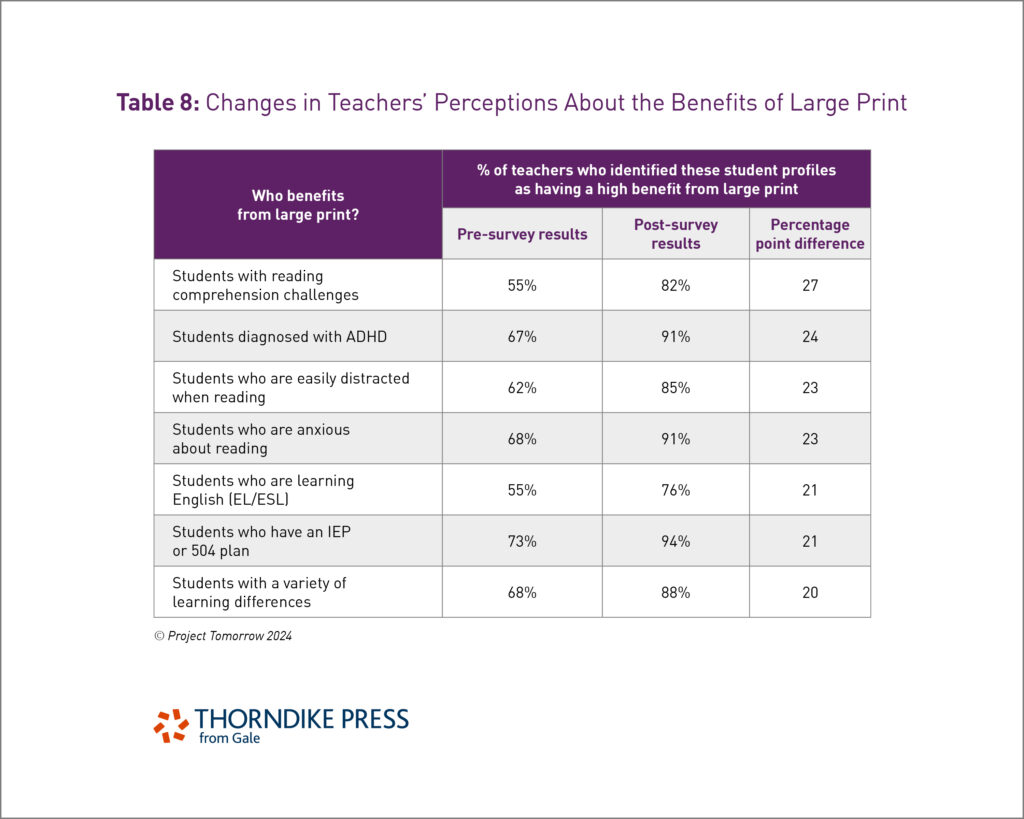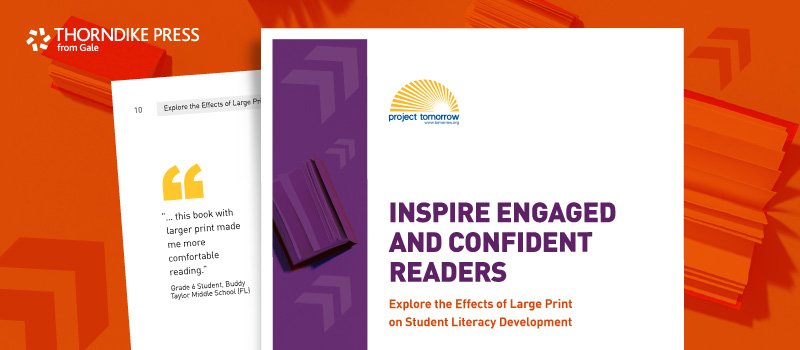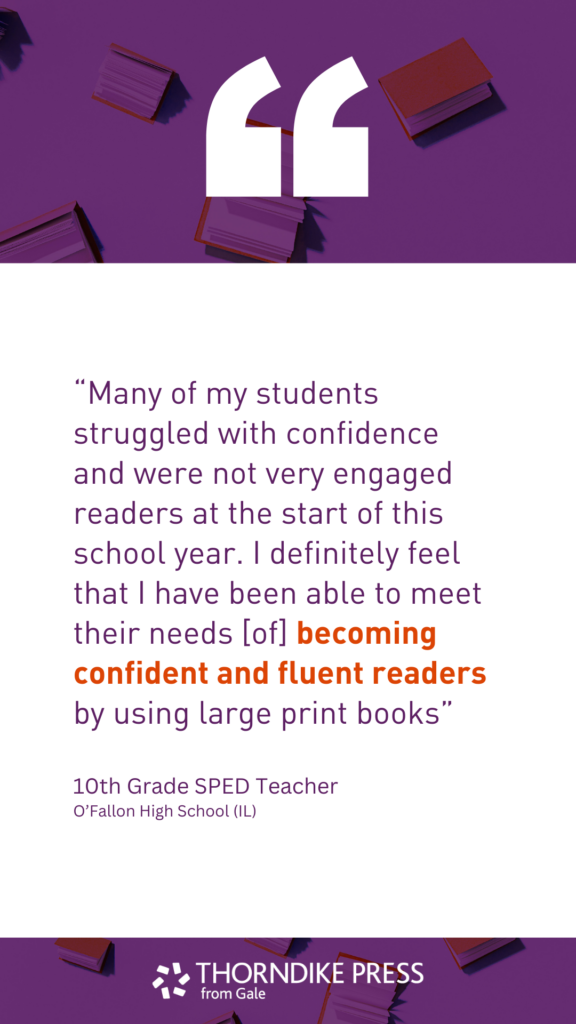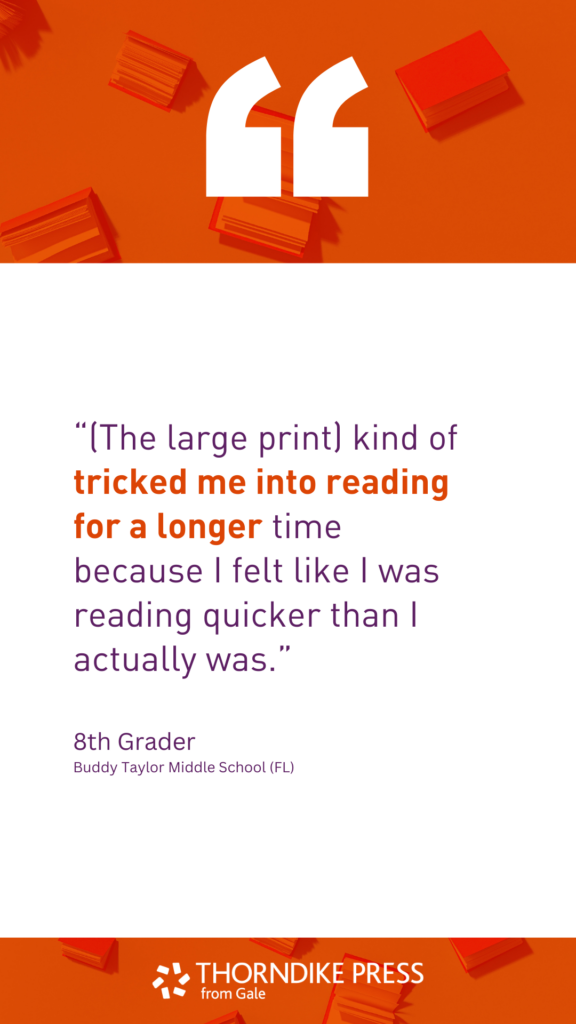| By Sabine McAlpine, VP of Thorndike Press |
Some of the biggest challenges educators currently face are closing achievement gaps and improving literacy proficiency for youth nationwide. Roughly two out of three students are reading below grade level.1 This lack of reading proficiency is immensely impactful not only to students’ educational experiences but also to their futures.
Educators are searching for effective, evidence-based literacy interventions backed by the science of reading to support student success. In addition to building key reading skills like decoding, fluency, and comprehension, teachers need resources that actually engage students with reading.
While there are many resources available to support literacy, performing meaningful research with real students in classroom environments gives us insights into what works. That’s why Thorndike Press partnered with Project TomorrowⓇ to conduct a nationwide study measuring the efficacy of large print books on student literacy.
As a publisher, we want educators and librarians to feel confident in choosing resources to create equitable, effective learning experiences. Our latest research with Project Tomorrow, including nationwide data from participating students across grades 4–12 and their teachers and librarians, points to large print as a simple solution that improves both reader engagement and reading skills.
Critical Needs for Student Literacy and Engagement Interventions
The first time we conducted research with Project Tomorrow was in 2019. Since then, several new changes and challenges have prompted the need for another look at large print’s influence on student reading outcomes.
From 2020 to 2022 in particular, reading scores dropped five points on The Nation’s Report Card from the National Center for Education Statistics (NCES), marking the largest reading score drop since 1990.2
Today’s students also have shorter attention spans, making them more challenging to engage. In our latest Project Tomorrow study, 96% of teachers said students get distracted easily while reading.3
Lastly, although social and emotional factors have always affected student performance, the past few years have seen a rise in student mental health issues. From 2020 to 2023, the number of students who reported that stress, anxiety, or depression makes it hard for them to do their best in school rose from 39% to 48%—up to nearly half of all students surveyed.4 Whether students are dealing with things at home or simply frustrated with schoolwork, teachers work constantly to help them overcome everyday anxieties to focus on learning.
To support improvements in student literacy, it’s clear that increasing student engagement first is key.
Making Reading More Accessible for Students
Over half of students self-report that they don’t like school reading.5 And many students who struggle with reading find creative ways to avoid it. I’ve seen this firsthand when I volunteered at my daughter’s school. My daughter, who had an IEP and was in the special education program, would look at her teacher with tears in her eyes so the teacher would skip over her for classroom read-alouds. I frequently saw a range of other behaviors kids would exhibit to get out of reading.
To help these students, we have to create an accessible, comfortable reading environment where they don’t feel frustrated or scared. While creating this comfortable space requires a lot of pieces, large print can serve an impactful role.
With a larger font size, expanded line spacing, and fewer words per page, large print is a more welcoming format than a standard print book. Instead of opening a book and being overwhelmed by the amount of text, students find large print more inviting. They can turn pages faster when they read large print, making them more motivated and engaged.
Notable Improvements in Reader Engagement and Confidence
These outcomes are evident in the 2023–2024 Project Tomorrow study. Perhaps the most important research finding is that large print increased students’ engagement in learning and enjoyment of reading.
Teachers reported that large print helps students stay focused. When observing below-grade-level readers who read large print, 84% of teachers said these students had longer sustained reading periods without being distracted and 75% said they increased their time spent reading.6
Additionally, over eight in ten teachers noted social and emotional outcomes of using large print books for students. Teachers said that students’ stress and anxiety associated with schoolwork reading decreased significantly—81% for below-grade-level readers and 71% for at-grade-level readers. Student confidence also soared while reading large print. According to 87% of teachers, below-grade-level readers demonstrated increased confidence in their reading abilities.7
Large Print Is an Equitable Solution for All Students
The study also demonstrates that large print supports a range of learners, from students at various reading levels to those with learning differences. In addition to evaluating outcomes by reading level, Project Tomorrow assessed the specific impacts of large print on other groups like students diagnosed with ADHD and English Learners (ELs). In our post-survey results, 91% of teachers said students diagnosed with ADHD highly benefitted from large print and 76% said ELs highly benefitted.8

An Effective Literacy Intervention That’s Easy to Implement
Data from the 2023–2024 study prove large print is effective in increasing student reading engagement and literacy skills. Large print makes an impact—and it’s easy to implement. We say large print is a simple literacy intervention because it doesn’t require modified lesson plans or extensive training. With large print, you’re simply offering students the choice to read a more accessible format.
I’ve heard so many stories from librarians and teachers about how they’ve given large print books to students who claim they don’t like reading. These students get excited when they realize large print is different. For example, a librarian from New York recently left me a voicemail with a story about how she gave a large print copy of The Wild Robot to a reluctant reader in 5th-grade. She said he came back the next day so excited that he’d read a whole chapter for the first time in his life, and he asked if he could stay in the library for the day to read his book.
It’s hard to imagine how a simple format can make such a huge difference for reluctant readers, but once librarians and teachers see it firsthand, it’s undeniable. This is how we want every student to feel about reading. We want to take away the intimidation and help more students find enjoyment in books.
Read the White Paper to Discover More Large Print Insights
As educators ask questions about how they can help close student achievement gaps and improve literacy proficiency, we’re so hopeful that large print is a simple, effective answer. Overall, 100% of teachers said it would be valuable to have more large print titles easily accessible for students in the 2023–2024 study.9 With large print, we can create more equitable learning experiences and make reading more accessible for all different types of learners.
Read the white paper now to explore data from the 2023–2024 large print efficacy study. See what students and educators report as their top literacy challenges, dive into how large print supports various student groups, and discover how large print can make an impact on your developing readers.
Notes:
- “NAEP Report Card: Reading,” The Nation’s Report Card, U.S. Department of Education, Institute of Education Sciences, National Center for Education Statistics, National Assessment of Educational Progress (NAEP), 2022.
- “NAEP Long-Term Trend Assessment Results: Reading and Mathematics,” The Nation’s Report Card, U.S. Department of Education, Institute of Education Sciences, National Center for Education Statistics, National Assessment of Educational Progress (NAEP), 2022.
- “Inspire Engaged and Confident Readers: Explore the Effects of Large Print on Student Literacy Development,” Project Tomorrow and Thorndike Press, December 2024.
- Wilka, Jen Vorse. “How Are Kids Really Doing after COVID-19? Survey of 500K Students Has Answers,” The 74 Million, September 2023.
- 6, 7, 8, 9 “Inspire Engaged and Confident Readers.”

About the Author
Sabine McAlpine is the vice president of Thorndike Press who partners with librarians and teachers to help students become stronger and more confident readers. Even before joining Thorndike Press twenty years ago, Sabine was passionate about sharing the love of reading and meeting young readers where they are. She’s volunteered in public libraries and schools to run story time, serve as a reading coach, and help children of all ages find joy in reading.




